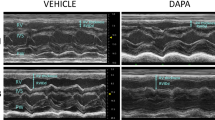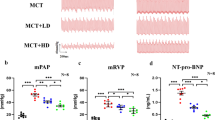Abstract
The rapid growth of cancer cells is permitted by metabolic changes, notably increased aerobic glycolysis and increased glutaminolysis. Aerobic glycolysis is also evident in the hypertrophying myocytes in right ventricular hypertrophy (RVH), particularly in association with pulmonary arterial hypertension (PAH). It is unknown whether glutaminolysis occurs in the heart. We hypothesized that glutaminolysis occurs in RVH and assessed the precipitating factors, transcriptional mechanisms, and physiological consequences of this metabolic pathway. RVH was induced in two models, one with PAH (Monocrotaline-RVH) and the other without PAH (pulmonary artery banding, PAB-RVH). Despite similar RVH, ischemia as determined by reductions in RV VEGFα, coronary blood flow, and microvascular density was greater in Monocrotaline-RVH versus PAB-RVH. A sixfold increase in 14C-glutamine metabolism occurred in Monocrotaline-RVH but not in PAB-RVH. In the RV working heart model, the glutamine antagonist 6-diazo-5-oxo-l-norleucine (DON) decreased glutaminolysis, caused a reciprocal increase in glucose oxidation, and elevated cardiac output. Consistent with the increased glutaminolysis in RVH, RV expressions of glutamine transporters (SLC1A5 and SLC7A5) and mitochondrial malic enzyme were elevated (Monocrotaline-RVH > PAB-RVH > control). Capillary rarefaction and glutamine transporter upregulation also occurred in RVH in patients with PAH. cMyc and Max, known to mediate transcriptional upregulation of glutaminolysis, were increased in Monocrotaline-RVH. In vivo, DON (0.5 mg/kg/day × 3 weeks) restored pyruvate dehydrogenase activity, reduced RVH, and increased cardiac output (89 ± 8, vs. 55 ± 13 ml/min, p < 0.05) and treadmill distance (194 ± 71, vs. 36 ±7 m, p < 0.05) in Monocrotaline-RVH. Glutaminolysis is induced in the RV in PAH by cMyc–Max, likely as a consequence of RV ischemia. Inhibition of glutaminolysis restores glucose oxidation and has a therapeutic benefit in vivo.
Key message
-
Patients with pulmonary artery hypertension (PAH) have evidence of cardiac glutaminolysis.
-
Cardiac glutaminolysis is associated with microvascular rarefaction/ischemia.
-
As in cancer, cardiac glutaminolysis results from activation of cMyc-Max.
-
The specific glutaminolysis inhibitor DON regresses right ventricular hypertrophy.
-
DON improves cardiac function and exercise capacity in an animal model of PAH.








Similar content being viewed by others
References
Kim JW, Dang CV (2006) Cancer's molecular sweet tooth and the Warburg effect. Cancer Res 66:8927–8930
Dang CV (2011) Therapeutic targeting of Myc-reprogrammed cancer cell metabolism. Cold Spring Harb Symp Quant Biol 76:369–374
Dang CV (2010) Glutaminolysis: supplying carbon or nitrogen or both for cancer cells? Cell Cycle 9:3884–3886
Bonnet S, Archer SL, Allalunis-Turner J, Haromy A, Beaulieu C, Thompson R, Lee CT, Lopaschuk GD, Puttagunta L, Harry G et al (2007) A mitochondria-K+ channel axis is suppressed in cancer and its normalization promotes apoptosis and inhibits cancer growth. Cancer Cell 11:37–51
Xu W, Koeck T, Lara AR, Neumann D, DiFilippo FP, Koo M, Janocha AJ, Masri FA, Arroliga AC, Jennings C et al (2007) Alterations of cellular bioenergetics in pulmonary artery endothelial cells. Proc Natl Acad Sci U S A 104:1342–1347
Marsboom G, Wietholt C, Haney CR, Toth PT, Ryan JJ, Morrow E, Thenappan T, Bache-Wiig P, Piao L, Paul J et al (2012) Lung (1)(8)F-fluorodeoxyglucose positron emission tomography for diagnosis and monitoring of pulmonary arterial hypertension. Am J Respir Crit Care Med 185:670–679
Piao L, Fang YH, Cadete VJ, Wietholt C, Urboniene D, Toth PT, Marsboom G, Zhang HJ, Haber I, Rehman J et al (2010) The inhibition of pyruvate dehydrogenase kinase improves impaired cardiac function and electrical remodeling in two models of right ventricular hypertrophy: resuscitating the hibernating right ventricle. J Mol Med 88:47–60
Stanley WC, Lopaschuk GD, Hall JL, McCormack JG (1997) Regulation of myocardial carbohydrate metabolism under normal and ischaemic conditions. Potential for pharmacological interventions. Cardiovasc Res 33:243–257
Marsboom G, Toth PT, Ryan JJ, Hong Z, Wu X, Fang YH, Thenappan T, Piao L, Zhang HJ, Pogoriler J et al (2012) Dynamin-related protein 1-mediated mitochondrial mitotic fission permits hyperproliferation of vascular smooth muscle cells and offers a novel therapeutic target in pulmonary hypertension. Circ Res 110:1484–1497
Fang YH, Piao L, Hong Z, Toth PT, Marsboom G, Bache-Wiig P, Rehman J, Archer SL (2012) Therapeutic inhibition of fatty acid oxidation in right ventricular hypertrophy: exploiting Randle's cycle. J Mol Med (Berl) 90:31–43
DeBerardinis RJ, Mancuso A, Daikhin E, Nissim I, Yudkoff M, Wehrli S, Thompson CB (2007) Beyond aerobic glycolysis: transformed cells can engage in glutamine metabolism that exceeds the requirement for protein and nucleotide synthesis. Proc Natl Acad Sci U S A 104:19345–19350
Bing RJ, Siegel A, Ungar I, Gilbert M (1954) Metabolism of the human heart. II. Studies on fat, ketone and amino acid metabolism. Am J Med 16:504–515
Mudge GH Jr, Mills RM Jr, Taegtmeyer H, Gorlin R, Lesch M (1976) Alterations of myocardial amino acid metabolism in chronic ischemic heart disease. J Clin Invest 58:1185–1192
Knapp WH, Helus F, Ostertag H, Tillmanns H, Kubler W (1982) Uptake and turnover of l-(13N)-glutamate in the normal human heart and in patients with coronary artery disease. Eur J Nucl Med 7:211–215
Bodi V, Sanchis J, Morales JM, Marrachelli VG, Nunez J, Forteza MJ, Chaustre F, Gomez C, Mainar L, Minana G et al (2012) Metabolomic profile of human myocardial ischemia by nuclear magnetic resonance spectroscopy of peripheral blood serum: a translational study based on transient coronary occlusion models. J Am Coll Cardiol 59:1629–1641
Ahuja P, Zhao P, Angelis E, Ruan H, Korge P, Olson A, Wang Y, Jin ES, Jeffrey FM, Portman M et al (2010) Myc controls transcriptional regulation of cardiac metabolism and mitochondrial biogenesis in response to pathological stress in mice. J Clin Invest 120:1494–1505
Piao L, Fang YH, Parikh KS, Ryan JJ, D'Souza KM, Theccanat T, Toth PT, Pogoriler J, Paul J, Blaxall BC et al (2012) GRK2-mediated inhibition of adrenergic and dopaminergic signaling in right ventricular hypertrophy: therapeutic implications in pulmonary hypertension. Circulation 126:2859–2869
Bogaard HJ, Natarajan R, Henderson SC, Long CS, Kraskauskas D, Smithson L, Ockaili R, McCord JM, Voelkel NF (2009) Chronic pulmonary artery pressure elevation is insufficient to explain right heart failure. Circulation 120:1951–1960
Sartoretto JL, Kalwa H, Shiroto T, Sartoretto SM, Pluth MD, Lippard SJ, Michel T (2012) Role of Ca2+ in the control of H2O2-modulated phosphorylation pathways leading to eNOS activation in cardiac myocytes. PLoS One 7:e44627
Mohl MC, Iismaa SE, Xiao XH, Friedrich O, Wagner S, Nikolova-Krstevski V, Wu J, Yu ZY, Feneley M, Fatkin D et al (2011) Regulation of murine cardiac contractility by activation of alpha(1A)-adrenergic receptor-operated Ca(2+) entry. Cardiovasc Res 91:310–319
Cohen DM, Guthrie PH, Gao X, Sakai R, Taegtmeyer H (2003) Glutamine cycling in isolated working rat heart. Am J Physiol Endocrinol Metab 285:E1312–E1316
Rennie MJ, Khogali SE, Low SY, McDowell HE, Hundal HS, Ahmed A, Taylor PM (1996) Amino acid transport in heart and skeletal muscle and the functional consequences. Biochem Soc Trans 24:869–873
Kaadige MR, Looper RE, Kamalanaadhan S, Ayer DE (2009) Glutamine-dependent anapleurosis dictates glucose uptake and cell growth by regulating MondoA transcriptional activity. Proc Natl Acad Sci U S A 106:14878–14883
Pongratz RL, Kibbey RG, Shulman GI, Cline GW (2007) Cytosolic and mitochondrial malic enzyme isoforms differentially control insulin secretion. J Biol Chem 282:200–207
Mandella RD, Sauer LA (1975) The mitochondrial malic enzymes. I. Submitochondrial localization and purification and properties of the NAD(P)+−dependent enzyme from adrenal cortex. J Biol Chem 250:5877–5884
Wise DR, Thompson CB (2010) Glutamine addiction: a new therapeutic target in cancer. Trends Biochem Sci 35:427–433
Arbiser JL, Arbiser ZK, Majzoub JA (1993) Differential regulation of choriocarcinoma gene expression by DNA synthesis inhibitors. Endocr J 40:263–268
Wise DR, DeBerardinis RJ, Mancuso A, Sayed N, Zhang XY, Pfeiffer HK, Nissim I, Daikhin E, Yudkoff M, McMahon SB et al (2008) Myc regulates a transcriptional program that stimulates mitochondrial glutaminolysis and leads to glutamine addiction. Proc Natl Acad Sci U S A 105:18782–18787
Baudino TA, McKay C, Pendeville-Samain H, Nilsson JA, Maclean KH, White EL, Davis AC, Ihle JN, Cleveland JL (2002) c-Myc is essential for vasculogenesis and angiogenesis during development and tumor progression. Genes Dev 16:2530–2543
Lauzier B, Vaillant F, Merlen C, Gelinas R, Bouchard B, Rivard ME, Labarthe F, Dolinsky VW, Dyck JR, Allen BG et al (2013) Metabolic effects of glutamine on the heart: anaplerosis versus the hexosamine biosynthetic pathway. J Mol Cell Cardiol 55:92–100
Ryan J, Bloch K, Archer SL (2011) Rodent models of pulmonary hypertension: harmonisation with the World Health Organisation's categorisation of human PH. Int J Clin Pract 65(Suppl 172):15–34
Enns GM, Berry SA, Berry GT, Rhead WJ, Brusilow SW, Hamosh A (2007) Survival after treatment with phenylacetate and benzoate for urea-cycle disorders. N Engl J Med 356:2282–2292
Hassanein M, Hoeksema MD, Shiota M, Qian J, Harris BK, Chen H, Clark JE, Alborn WE, Eisenberg R, Massion PP (2013) SLC1A5 mediates glutamine transport required for lung cancer cell growth and survival. Clin Cancer Res 19:560–570
Wang H, Hammoudeh DI, Follis AV, Reese BE, Lazo JS, Metallo SJ, Prochownik EV (2007) Improved low molecular weight Myc–Max inhibitors. Mol Cancer Ther 6:2399–2408
Acknowledgments
Dr. Archer is supported by NIH-RO1-HL071115 and 1RC1HL099462-01 and the American Heart Association. The authors thank Dr. E. Kenneth Weir for his help in critiquing this manuscript.
Disclosures
The authors have no conflicts to disclose.
Author information
Authors and Affiliations
Corresponding author
Additional information
Lin Piao and Yong-Hu Fang contributed equally to this work.
Electronic supplementary material
Below is the link to the electronic supplementary material.
ESM 1
(PDF 765 kb)
Rights and permissions
About this article
Cite this article
Piao, L., Fang, YH., Parikh, K. et al. Cardiac glutaminolysis: a maladaptive cancer metabolism pathway in the right ventricle in pulmonary hypertension. J Mol Med 91, 1185–1197 (2013). https://doi.org/10.1007/s00109-013-1064-7
Received:
Revised:
Accepted:
Published:
Issue Date:
DOI: https://doi.org/10.1007/s00109-013-1064-7




